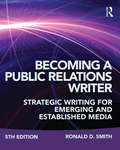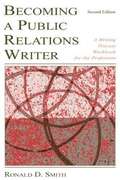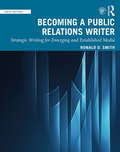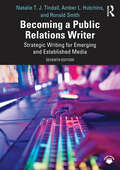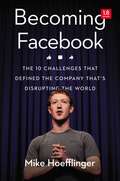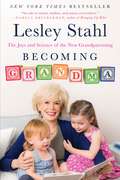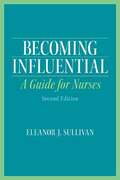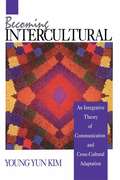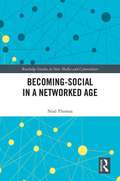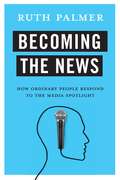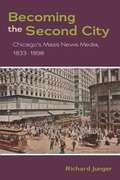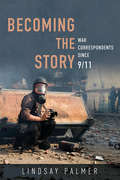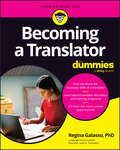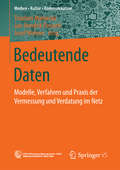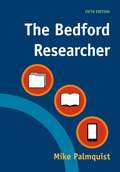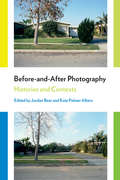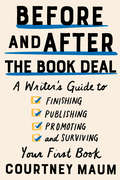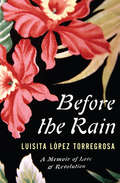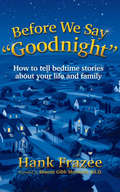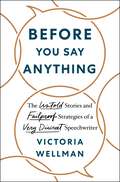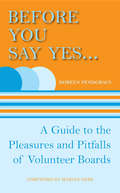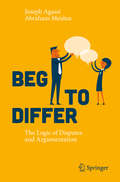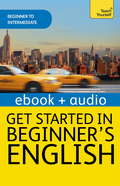- Table View
- List View
Becoming a Public Relations Writer: Strategic Writing for Emerging and Established Media
by Ronald D. SmithBecoming a Public Relations Writer is a comprehensive guide to the writing process for public relations practice. Using straightforward, no-nonsense language, realistic examples, easy-to-follow steps, and practical exercises, this text introduces the various formats and styles of writing you will encounter as a public relations practitioner. A focus on ethical and legal issues is woven throughout, with examples and exercises addressing public relations as practiced by corporations, non-profit agencies, and other types of organizations both large and small. In addition, the book offers the most comprehensive list of public relations writing formats to be found anywhere--from the standard news release to electronic mail and other opportunities using a variety of technologies and media. The fifth edition has been updated to reflect significant developments in the public relations field, including: New and updated information on research into persuasion and social psychology aimed at helping readers be more influential in their writing. Significant updating on a new chapter on multimedia, introducing a new transmedia format for a comprehensive news package for print, broadcast, online and social media. Expansion of a chapter on websites, blogs and wikis. Expansion of the chapter on direct mail and online appeals. Updated examples of actual pieces of public relations writing. A companion website with resources for instructors and students, including a glossary, flashcards, exercises, and appendices on ethical standards, careers in public relations, and professional organizations. Through its comprehensive and accessible approach, Becoming a Public Relations Writer is an invaluable resource for future and current public relations practitioners.
Becoming a Public Relations Writer: A Writing Process Workbook for the Profession (second edition)
by Ronald D. SmithFrom the book: "Becoming a Public Relations Writer" has been written to help guide you through the writing process. It will lead you through the various steps and stages of writing and will help you explore many formats and styles necessary to public relations writers. Because this book grows out of the author's professional and teaching experience, it is limited to the insight of one person. Your own experiences and those of your instructor and colleagues are likely to add to the conclusions and the advice offered here.
Becoming a Public Relations Writer: Strategic Writing for Emerging and Established Media
by Ronald D. SmithThe sixth edition of Becoming a Public Relations Writer continues its place as an essential guide to the writing process for public relations practice. Smith provides comprehensive examples, guidelines and exercises that allow students to both learn the fundamentals of public relations writing and practice their writing skills. Ethical and legal issues are woven throughout the text, which covers public relations writing formats for both journalistic and organizational media. This new edition updates and expands its coverage of writing for digital and social media—including blogs, websites and wikis, as well as social networking (Facebook), microblogging (Twitter), photo sharing (Instagram and Snapchat) and video sharing (YouTube). This range reflects the current landscape of public relations writing, preparing undergraduate students for a public relations career. Becoming a Public Relations Writer is a trusted resource for courses in public relations, media writing and strategic communication. Previous editions of this text have been adopted by more than 190 colleges and universities in the U.S. and among other English-speaking nations. Complementary online materials are provided for both instructors and students; instructors have access to support materials such as test banks, chapter overviews and a sample syllabus, while students will benefit from career prep resources such as ethics codes, an overview of professional organizations and sample news packages. Visit the Companion Website at www.routledge.com/cw/smith.
Becoming a Public Relations Writer: Strategic Writing for Emerging and Established Media
by null Natalie T. Tindall null Amber L. Hutchins null Ronald D. SmithThe seventh edition of Becoming a Public Relations Writer serves as an essential guide to the writing process for public relations practice. The text covers public relations writing formats across digital and traditional media, providing comprehensive examples, guidelines, and exercises to learn the fundamentals of public relations writing and help students practice their writing and editing skills. This new edition is significantly streamlined with numerous updates throughout. It features updated diverse and inclusive examples and expands its coverage of writing for digital and social media, addressing influencer relations, media pitching, and media catching. A standalone chapter on ethics and legal issues for the PR writer also informs every chapter of the text. Helpful pedagogy includes in-class discussion prompts and writing assignments. This seventh edition is an ideal text for undergraduate and postgraduate courses in public relations writing. Free additional online resources include chapter summaries, assignments, test bank, sample syllabi, and other resources for the PR writer. Please visit www.routledge.com/9781032159324.
Becoming A Better Communicator: A Basic Course in Interpersonal and Public Communication
by Matthew Olsen Rhonda Gallagher Agena Farmer Susan Mcmurray Denise MillerBecoming a Better Communicator: A Basic Course in Interpersonal and Public Communication.
Becoming Facebook: The 10 Challenges That Defined the Company that's Disrupting the World
by Mike HoefflingerFacebook’s founding is legend: In a Harvard dorm, wunderkind Mark Zuckerberg invented a new way to connect with friends…and the rest is history. But for the people who actually molded this great idea into a game-changing $300 billion company, the experience was far more tumultuous and uncertain than we might expect.Mike Hoefflinger was one of those Facebook insiders. As a computer engineer turned marketing innovator who worked with COO Sheryl Sandberg, Hoefflinger had a front-row seat to the company’s growing pains, stumbles, and reinventions.Becoming Facebook tells the coming-of-age story of the now venerable giant. Filled with insights and anecdotes from crises averted and challenges solved, the book tracks the company’s development, uncovering lessons learned on its way to greatness:How Facebook recovered from its “disastrous” IPO How the growth team achieved the impossible Why Facebook’s News Feed ads were the company’s most important business decision ever How Google+ attacked and lost Why—and how—Instagram and WhatsApp were added to the mix What the company does to win the talent wars What makes Zuckerberg, Sandberg, Cox, and other A-teamers tick Which products and technical advancements are on the horizon and why And much moreIntimate, fast-paced, and deeply informative, Becoming Facebook shares the true story of how Zuckerberg joined the ranks of iconic CEOs like Steve Jobs, Larry Page, and Jeff Bezos—as Facebook grows up, overcomes setbacks, and works to connect the world.
Becoming Grandma: The Joys and Science of the New Grandparenting
by Lesley Stahl<P>From one of the country's most recognizable journalists: How becoming a grandmother transforms a woman's life. <P>After four decades as a reporter, Lesley Stahl's most vivid and transformative experience of her life was not covering the White House, interviewing heads of state, or researching stories at 60 Minutes. It was becoming a grandmother. She was hit with a jolt of joy so intense and unexpected, she wanted to "investigate" it--as though it were a news flash. <P>And so, using her 60 Minutes skills, she explored how grandmothering changes a woman's life, interviewing friends like Whoopi Goldberg, colleagues like Diane Sawyer (and grandfathers, including Tom Brokaw), as well as the proverbial woman next door. <P>Along with these personal accounts, Stahl speaks with scientists and doctors about physiological changes that occur in women when they have grandchildren; anthropologists about why there are grandmothers, in evolutionary terms; and psychiatrists about the therapeutic effects of grandchildren on both grandmothers and grandfathers. <P>Throughout Becoming Grandma, Stahl shares stories about her own life with granddaughters Jordan and Chloe, about how her relationship with her daughter, Taylor, has changed, and about how being a grandfather has affected her husband, Aaron. <P>In an era when baby boomers are becoming grandparents in droves and when young parents need all the help they can get raising their children, Stahl's book is a timely and affecting read that redefines a cherished relationship. <P><b>A New York Times Bestseller</b>
Becoming Influential: A Guide for Nurses
by Eleanor J. SullivanStill the only book of its kind, this intensely practical text helps nurses build the skills they need to gain and use influence throughout their entire careers. This second edition is updated throughout with new information on nursing, health care, and technology - including social media. Readable, timely, and upbeat, this book teaches through real-life examples, offering proven advice for using influence to solve many contemporary workplace problems. Self-assessments help readers evaluate their current organizational power, communication, goal-setting skills, negotiating and interviewing expertise, and even their abilities to manage confrontation. The book contains specific steps for career planning, resume building, career progress tracking, speech preparation, and more. Flexible learning activities include role plays, debates, observations, interviews, and networking assignments; up-to-date web and print resources support further exploration.
Becoming Intercultural: An Integrative Theory of Communication and Cross-Cultural Adaptation
by Young Yun KimThis book looks at the movements of immigrants and refugees and the challenges they face as they cross cultural boundaries and strive to build a new life in an unfamiliar place. It focuses on the psychological dynamic underpinning of their adaptation process, how their internal conditions change over time, the role of their ethnic and personal backgrounds, and of the conditions of the host environment affecting the process. Addressing these and related issues, the author presents a comprehensive theory, or a "big picture,"of the cross-cultural adaptation phenomenon.
Becoming-Social in a Networked Age (Routledge Studies in New Media and Cyberculture)
by Neal ThomasThis book examines the semiotic effects of protocols and algorithms at work in popular social media systems, bridging philosophical conversations in human-computer interaction (HCI) and information systems (IS) design with contemporary work in critical media, technology and software studies. Where most research into social media is sociological in scope, Neal Thomas shows how the underlying material-semiotic operations of social media now crucially define what it means to be social in a networked age. He proposes that we consider social media platforms as computational processes of collective individuation that produce, rather than presume, forms of subjectivity and sociality.
Becoming the News: How Ordinary People Respond to the Media Spotlight
by Ruth PalmerWhat does it feel like to be featured, quoted, or just named in a news story? A refugee family, the survivor of a shooting, a primary voter in Iowa—the views and experiences of ordinary people are an important component of journalism. While much has been written about how journalists work and gather stories, what do we discover about the practice of journalism and attitudes about the media by focusing on the experiences of the subjects themselves? In Becoming the News, Ruth Palmer argues that understanding the motivations and experiences of those who have been featured in news stories—voluntarily or not—sheds new light on the practice of journalism and the importance many continue to place on the role of the mainstream media.Based on dozens of interviews with news subjects, Becoming the News studies how ordinary people make sense of their experience as media subjects. Palmer charts the arc of the experience of “making” the news, from the events that brought an ordinary person to journalists’ attention through the decision to cooperate with reporters, interactions with journalists, and reactions to the news coverage and its aftermath. She explores what motivates someone to talk to the press; whether they consider the potential risks; the power dynamics between a journalist and their subject; their expectations about the motivations of journalists; and the influence of social media on their decisions and reception. Pointing to the ways traditional news organizations both continue to hold on to and are losing their authority, Becoming the News has important implications for how we think about the production and consumption of news at a time when Americans distrust the news media more than ever.
Becoming the Second City: Chicago's Mass News Media, 1833-1898
by Richard JungerBecoming the Second City examines the development of Chicago's press and analyzes coverage of key events in its history to call attention to the media's impact in shaping the city's cultural and historical landscape. In concise, extensively documented prose, Richard Junger illustrates how nineteenth century newspapers acted as accelerants that boosted Chicago's growth in its early history by continually making and remaking the city's image for the public. Junger argues that the press was directly involved in Chicago's race to become the nation's most populous city, a feat it briefly accomplished during the mid-1890s before the incorporation of Greater New York City irrevocably recast Chicago as the "Second City. " The book is populated with a colorful cast of influential figures in the history of Chicago and in the development of journalism. Junger draws on newspapers, personal papers, and other primary sources to piece together a lively portrait of the evolving character of Chicago in the nineteenth century. Highlighting the newspaper industry's involvement in the business and social life of Chicago, Junger casts newspaper editors and reporters as critical intermediaries between the elite and the larger public and revisits key events and issues including the Haymarket Square bombing, the 1871 fire, the Pullman Strike, and the World's Columbian Exposition in 1893.
Becoming the Story: War Correspondents since 9/11
by Lindsay PalmerThe September 11 attacks produced changes in journalism and the lives of the people who practiced it. Foreign reporters felt surrounded by the hate of American colleagues for "the enemy." Americans in combat areas became literal targets of anti-U.S. sentiment. Behind the lines, editors and bureau chiefs scrambled to reorient priorities while feeling the pressure of sending others into danger. Becoming the Story examines the transformation of war reporting in the decade after 9/11. Lindsay Palmer delves into times when print or television correspondents themselves received intense public scrutiny because of an incident associated with the work of war reporting. Such instances include Daniel Pearl's kidnapping and murder; Bob Woodruff's near-fatal injury in Iraq; the expulsions of Maziar Bahari and Nazila Fathi from Iran in 2009; the sexual assault of Lara Logan; and Marie Colvin's 2012 death in Syria. Merging analysis with in-depth interviews of Woodruff and others, Palmer shows what these events say about how post-9/11 conflicts transformed the day-to-day labor of reporting. But they also illuminate how journalists' work became entangled with issues ranging from digitization processes to unprecedented hostility from all sides to the political logic of the War on Terror.
Becoming A Translator For Dummies
by Regina GalassoUnlock the intriguing world of translation and embark on a fulfilling career path Becoming A Translator For Dummies is your gateway to the exciting world of translation. This comprehensive guide will equip you with the tools and knowledge to succeed in this dynamic field, regardless of the specific field you choose to enter. Dr. Regina Galasso unveils the secrets of becoming a successful translator. You'll explore the different facets of translation, understand the nuances between translation and interpretation, and uncover the myriad exciting career opportunities available in this ever-expanding industry. Learn about the skills you’ll need to master to become a professional translator Explore freelance, part-time, and full-time job options, and market yourself effectively Discover specialized translation opportunities like legal, medical, technical, and literary translation Find top-notch translator programs and certificationsPrepare yourself for a career that knows no boundaries! Language enthusiasts, novice translators, and those already studying to become translation pros will love the valuable insights and practical advice in Becoming A Translator For Dummies.
Bedeutende Daten: Modelle, Verfahren und Praxis der Vermessung und Verdatung im Netz (Medien • Kultur • Kommunikation)
by Thorben Mämecke Jan-Hendrik Passoth Josef WehnerDieser Band diskutiert die Entwicklung, dass, wer sich im Netz bewegt, mit Beobachtung rechnen muss. Mit immer geringerem Aufwand sind sowohl Regierungen, Wirtschaftsunternehmen, Meinungs- und Konsumforschung als auch Privatpersonen in der Lage, Netzaktivitäten und Datenspuren zu erfassen und zu analysieren.
The Bedford Researcher
by Mike PalmquistTech-savvy and student-friendly, The Bedford Researcher addresses the kinds of writing students actually do and the kinds of sources they actually use, from multimodal projects and oral presentations to Web sites and digital databases. The Bedford Researcher strips away the complexities of research writing across the disciplines and offers the practical help students need to write with confidence while integrating electronic sources and tools into each stage of the process.
Before-and-After Photography: Histories and Contexts
by Jordan BearThe before-and-after trope in photography has long paired images to represent change: whether affirmatively, as in the results of makeovers, social reforms or medical interventions, or negatively, in the destruction of the environment by the impacts of war or natural disasters. This interdisciplinary, multi-authored volume examines the central but almost unspoken position of before-and-after photography found in a wide range of contexts from the 19th century through to the present. Packed with case studies that explore the conceptual implications of these images, the book’s rich language of evidence, documentation and persuasion present both historical material and the work of practicing photographers who have deployed – and challenged – the conventions of the before-and-after pairing. Touching on issues including sexuality, race, environmental change and criminality, Before-and-After Photography examines major topics of current debate in the critique of photography in an accessible way to allow students and scholars to explore the rich conceptual issues around photography’s relationship with time andimagination.
Before and After the Book Deal: A Writer's Guide to Finishing, Publishing, Promoting, and Surviving Your First Book
by Courtney MaumEverything you’ve ever wanted to know about publishing but were too afraid to ask is right here in this funny, candid guide written by an acclaimed author.There are countless books on the market about how to write better but very few books on how to break into the marketplace with your first book. Cutting through the noise (and very mixed advice) online, while both dispelling rumors and remaining positive, Courtney Maum's Before and After the Book Deal is a one–of–a–kind resource that can help you get your book published.Before and After the Book Deal: A Writer's Guide to Finishing, Publishing, Promoting, and Surviving Your First Book has over 150 contributors from all walks of the industry, including international bestselling authors Anthony Doerr, Roxane Gay, Garth Greenwell, Lisa Ko, R. O. Kwon, Rebecca Makkai, and Ottessa Moshfegh, alongside cult favorites Sarah Gerard, Melissa Febos, Mitchell S. Jackson, and Mira Jacob.Agents, film scouts, film producers, translators, disability and minority activists, and power agents and editors also weigh in, offering advice and sharing intimate anecdotes about even the most taboo topics in the industry. Their wisdom will help aspiring authors find a foothold in the publishing world and navigate the challenges of life before and after publication with sanity and grace.Are MFA programs worth the time and money? How do people actually sit down and finish a novel? Did you get a good advance? What do you do when you feel envious of other writers? And why the heck aren’t your friends saying anything about your book? Covering questions ranging from the logistical to the existential (and everything in between), Before and After the Book Deal is the definitive guide for anyone who has ever wanted to know what it’s really like to be an author.
Before George Eliot
by Fionnuala DillaneFionnuala Dillane revisits the first decade of Marian Evans's working life to explore the influence of the periodical press on her emergence as George Eliot and on her subsequent responses to fame. This interdisciplinary study discusses the significance of Evans's work as a journalist, editor and serial-fiction writer in the periodical press from the late 1840s to the late 1850s and positions this early career against critical responses to Evans's later literary persona, George Eliot. Dillane argues that Evans's association with the nineteenth-century periodical industry, that dominant cultural force of the age, is important for its illumination of Evans's understanding of the formation of reading audiences, the development of literary genres and the cultivation of literary celebrity.
Before the Rain: A Memoir Of Love And Revolution
by Luisita Lopez TorregrosaIn a voice haunting and filled with longing, Before the Rain tells the story of love unexpected, its fragile bounds and subtle perils. As a newspaper editor in the '80s, Luisita Torregrosa lived her career. Enter Elizabeth, a striking, reserved, and elusive writer with whom Torregrosa falls deeply in love. Their story--irresistible romance, overlapping ambitions, and fragile union--unfolds as the narrative shifts to the Philippines and the fall of Ferdinand Marcos. There, on that beautiful, troubled island, the couple creates a world of their own, while covering political chaos and bloody upheavals. What was effortless abroad becomes less idyllic when they return to the United States, and their ending becomes as surprising and revealing as their beginning. Torregrosa captures the way love transforms those who experience it for an unforgettable, but often too brief, time. This book is distinguished not only by its strong, unique, and conflicted heroines, but also by Torregrosa's lyrical portrait of the Philippines and the even more exotic heart of intimacy.
Before We Say "Goodnight": How to Tell Bedtime Stories About Your Life and Family
by Hank FrazeeA unique way to turn bedtime stories into an opportunity to strengthen our bond with our children. Before We Say &“Goodnight&” will show you how to captivate your child&’s imagination with a subject they literally can&’t get enough of—you. In this book, you&’ll discover an easy-to-learn three-step method to turn your life experiences, and those of your family, into great bedtime stories, all without notes or memorization. Best of all, you&’ll make bedtime one of the happiest parts of the day. &“Our children and grandchildren want to know who we really are. This book provides a wonderful method to share our life with those we love. It&’s out of this world!&” —Buzz Aldrin, astronaut
Before You Say Anything: The Untold Stories and Failproof Strategies of a Very Discreet Speechwriter
by Victoria WellmanThe convention-breaking creative process of New York's busiest speechwriter, offering a holistic approach to crafting every kind of speech.The ability to express yourself in words has become both a rite of passage and an essential skill for anyone who wants to make a difference within their family, community, workplace, or beyond. And yet, strategies for engaging a new generation of media and tech-savvy audiences have failed to keep up with the times, leaving speakers wondering how to articulate a resonant message that bristles with detail, authenticity, and emotional truth. While we can’t all expect to captivate and inspire millions as Barack Obama and Greta Thunberg have, every speaker—regardless of their experience—can follow a road map to elevate a narrative from serviceable to unforgettable. This is true whether you’re roasting a colleague at an office party, delivering a keynote industry address, accepting an award, or eulogizing a loved one. In Before You Say Anything, Victoria Wellman—the founder and president of Manhattan-based speechwriting company The Oratory Laboratory—shares her unique methodology for researching, reimagining, crafting, and delivering an outstanding speech by focusing on three core objectives: respect for the audience, the restless pursuit of originality, and intentionality behind every word. Full of hilarious anecdotes and examples from Wellman’s extensive experience as the go-to speechwriter for power players and everyday people from around the world, Before You Say Anything is an irresistible antidote to the age-old doctrine of what a speech must include. Instead, it will leave readers with an enlightened and refreshing way of thinking about their sources, ideas, and material, and give them a strategy for putting it all to use.
Before You Say Yes ...: A Guide to the Pleasures and Pitfalls of Volunteer Boards
by Doreen PendgracsDoreen Pendgracs has sat on various boards of directors for the past twenty-five years. During that time, she has gleaned valuable information that she shares in an easy-to-understand, conversational style for novices and seasoned members alike. Whether you’re asked to sit on a trade union board, a non-profit board for a community group or church, a business-focused board of an association or chamber of commerce, or the board of a charitable organization, Before You Say Yes … gives you the inside scoop on what questions to ask and what you need to do before you take the plunge. Ms. Pendgracs leads the reader through the intricacies of management style, board etiquette and responsibilities, Robert’s Rules of Order, directors’ and officers’ insurance, and financial obligations and compensation. You’ll also discover what happens in the case of a lawsuit or how to implement a disaster plan, how to welcome new board members and deal with difficult people, and what benefits board membership can bring to your personal life and career.
Beg to Differ: The Logic of Disputes and Argumentation
by Joseph Agassi Abraham MeidanThis book aims to familiarize readers in a very simple and easy mannerthe rules and proper procedures of rational debate. It will help reducethe frustration that many experience when engaging in debates. The properconduct of debate is both fun and mentally stimulating, and we trust that implementing the rules ofdebate outlined in this book will help you and your friends increase yourability to learn, improve and engage in rational and intellectual debates.
Beginner's English: Enhanced Edition (TY English as a Foreign Language)
by Cindy CheethamDo you want a solid foundation to your English studies?If you are looking for a solid foundation to your language studies for school, work or travel, this engaging course will get you speaking, writing, reading and understanding English in no time. Through authentic conversations, clear language presentations, and extensive practice and review, you will learn the English you need to communicate naturally in everyday situations - from booking a hotel room to talking about friends and family.What will I learn?The course focuses on American English but offers British alternatives. Basic English is slowly and carefully introduced to ensure you progress confidently through the course and build up a foundation to allow you to feel confident in everyday situations and move to the next level of your learning. It teaches grammar, vocabulary and listening, reading, writing, speaking and pronunciation skills. By the end of the course you will reach a solid Novice High proficiency level of ACTFL (The American Council for the Teaching of Foreign Languages) and A2 Beginner level of the CEFR (Common European Framework of Reference for Languages) guidelines. Is this course for me?Get Started in English is for absolute and false beginners of English. Clear and simple explanations make the course appropriate and accessible to anyone learning English. There are extensive illustrations to support the learner working on his or her own. This course is also ideal to use with one-to-one tutoring and as a classroom course.What do I get? This enhanced eBook has a learner-centred approach that incorporates the following features:- 10 units of learning content - covering everyday topics from booking a hotel room to talking about friends and family- Discovery Method - figure out rules and patterns yourself to make the language stick- Outcomes-based learning - focus your studies with clear aims- Vocabulary building - thematic lists and activities to help you learn vocabulary quickly- Test yourself - see and track your own progress- Native speaker audio - integrated within the eBook- Free, downloadable audio transcripts and vocabulary and language reference listsWhere do I go next?If you want to advance your English, our Complete English as a Foreign Language course (9781473601581) will take you to an intermediate level of English.If you want to practice your speaking and listening skills, Get Talking and Keep Talking English (9781444193152) is the perfect audio course. It is available in English, French, Spanish, Italian and Portuguese instruction.**If you are looking for a British English course, you can try Get Started in British English (9781473612143).Rely on Teach Yourself, trusted by language learners for over 75 years.
